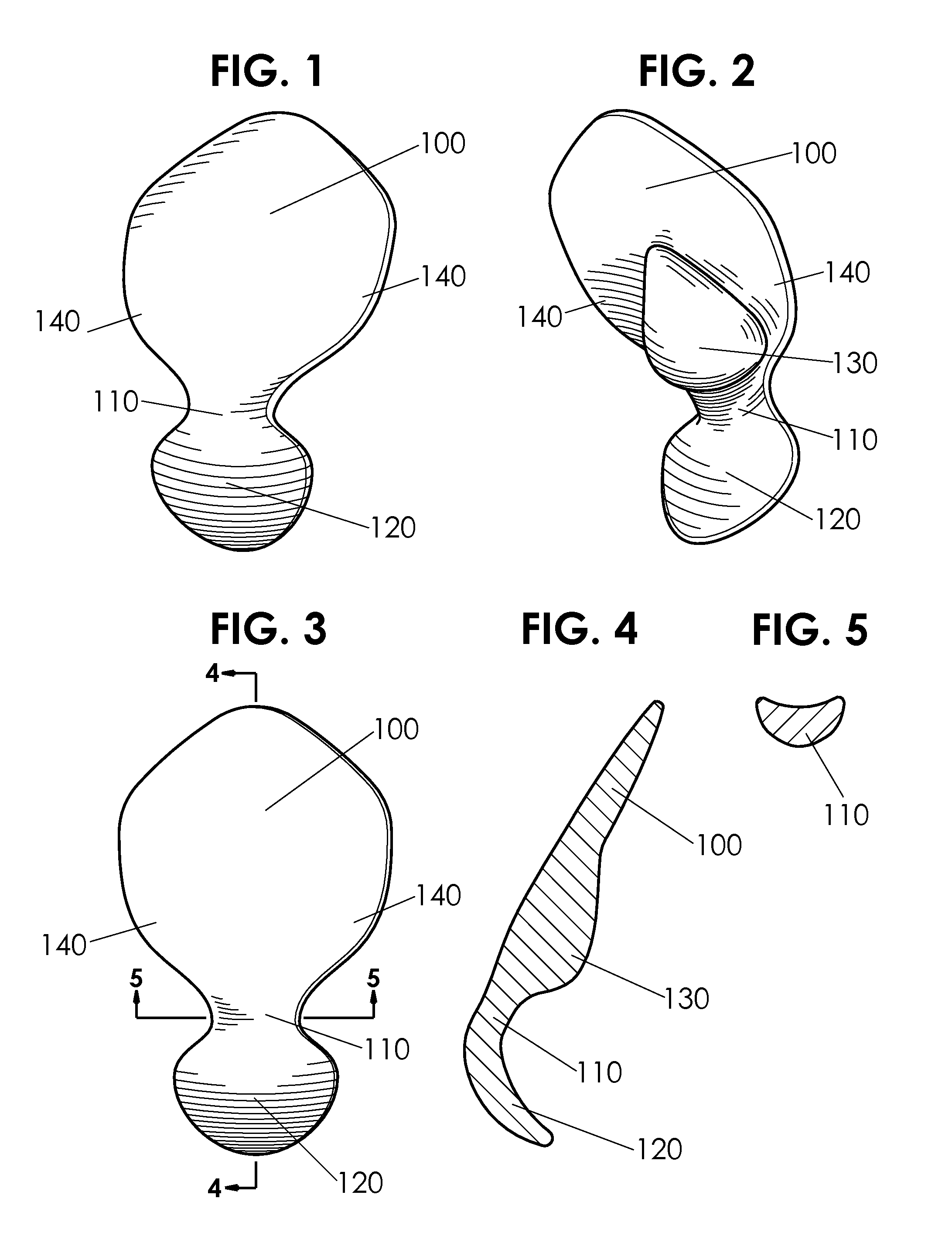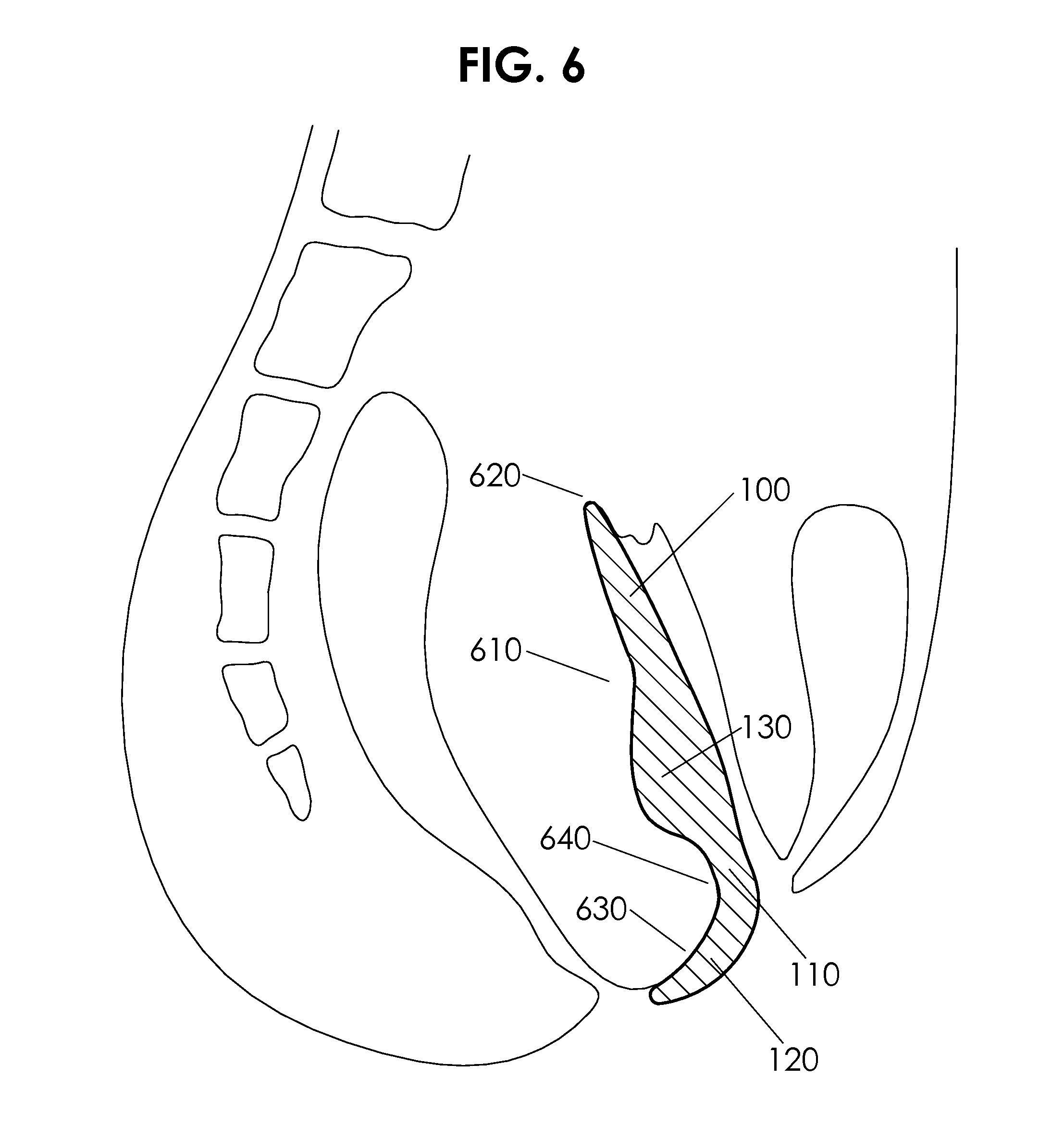Female posterior wall prosthesis
a posterior vaginal wall and prosthesis technology, applied in the field of medical devices, can solve the problems of loss of elasticity of pain of remaining healed scar on the posterior vaginal wall, and loss of elasticity of the vaginal and vaginal entran
- Summary
- Abstract
- Description
- Claims
- Application Information
AI Technical Summary
Benefits of technology
Problems solved by technology
Method used
Image
Examples
first embodiment
FIGS. 1-6—First Embodiment
[0055]One embodiment of the posterior vaginal wall prosthesis which resembles a paddle with a curved handle is illustrated in FIGS. 1-5. This embodiment comprises a flattened lobe 100, a neck 110, a handle 120, and a retention bulb 130. The flattened lobe 100 includes two side wings 140, 140. The neck 110 connects the flattened lobe 100 to the handle 120 as illustrated in FIG. 1. This embodiment comprises a flexible, resilient, unitary structure wherein the flattened lobe 100 and the handle 120 are disposed in divergent relation with an included angle in between. Within this included angle, the tear-drop shaped retention bulb 130 is positioned at the base of the flattened lobe 100 near the neck 110 with the largest part of the bulb placed closest to the neck 100 as shown in FIG. 2. The posterior vaginal wall prosthesis is sized and configured to be placed in a human female vagina as shown in FIG. 6 so that the end of the flattened lobe 100 is disposed towar...
second embodiment
FIGS. 7-11—Second Embodiment
[0061]Another embodiment of the posterior vaginal wall prosthesis is shown in FIGS. 7-11. The embodiment shown in FIGS. 7-11 comprises texture 280 on the non-bulb side, a deformable lobe retainer 240 embedded in the flattened lobe 100, a deformable handle retainer 250 embedded in the handle 120, finger holes 260 and 270, and a recess 290 in the retention bulb. Texture 280 is provided on the flattened lobe 100 on the non-bulb side and serves to act as a further means of retention by creating a higher friction surface. This surface texture 280 serves to enhance stimulation to the male sex organ and effectively duplicate the texture of the posterior vaginal wall 610. Note that localized texture 280 or texture 280 on the entire surface of the prosthesis aids to keep tampons in place. The deformable lobe retainer 240 applies continuous pressure in an attempt to flatten out the flattened lobe 100 in the vagina after insertion. The shape of the flattened lobe 10...
third embodiment
FIGS. 12-16—Third Embodiment
[0069]The embodiment of FIGS. 12-16 illustrates an embodiment of the prosthesis with a combined retainer 310. The combined retainer 310 is a unitary retainer that combines the lobe retainer 240 and the handle retainer 250 and passes through the neck 110. The combined retainer has the same purpose as the separate retainers, serving to unroll the prosthesis after being rolled up and inserted into the vagina. The combined retainer 310 also holds the flattened lobe 100 in place within the vagina and prevents the handle from entering the vagina before, during and after coitus.
[0070]The preferred material for the manufacture of this embodiment is the same material as the material described for the first embodiment shown in FIGS. 1-5. The combined retainer 310 is made of a similar and more rigid material to facilitate the added flexural function. The preferred material for the manufacture of the combined retainer 310 is that of the lobe retainer 240 material des...
PUM
 Login to View More
Login to View More Abstract
Description
Claims
Application Information
 Login to View More
Login to View More - R&D
- Intellectual Property
- Life Sciences
- Materials
- Tech Scout
- Unparalleled Data Quality
- Higher Quality Content
- 60% Fewer Hallucinations
Browse by: Latest US Patents, China's latest patents, Technical Efficacy Thesaurus, Application Domain, Technology Topic, Popular Technical Reports.
© 2025 PatSnap. All rights reserved.Legal|Privacy policy|Modern Slavery Act Transparency Statement|Sitemap|About US| Contact US: help@patsnap.com



